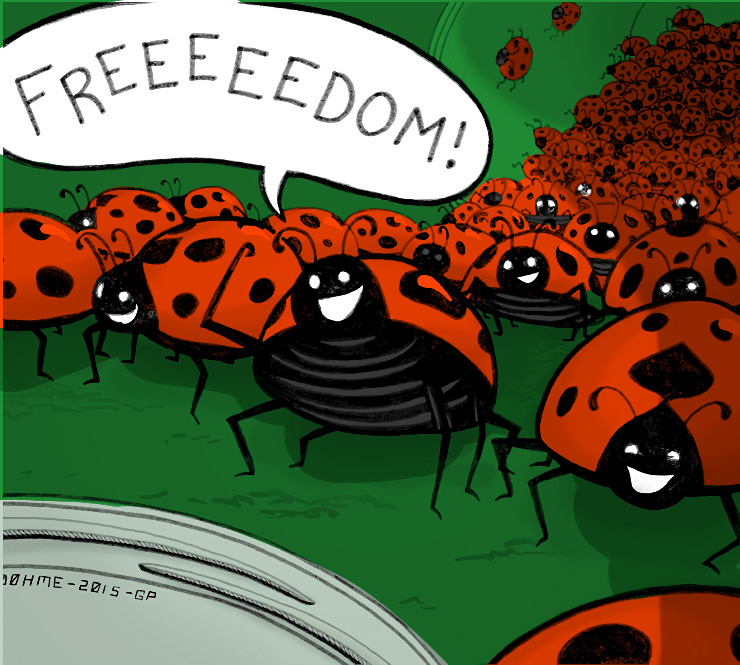Read by Michael Flamel
It all started with my noticing puckered, corrugated leaves on my river birch. It is still a young tree and susceptible to the ravages of critters and disease. At a local nursery, a young man immediately offered a diagnosis, a cure, and an analysis of the cost: “Aphids. Buy ladybugs. Release them at 8:30 in the evening. They come 1500 to a container, and the container costs only $5.95. That’s 0.4 cents per ladybug, a real bargain!”
I invested the $5.95 as advised.
About 8:25 that evening, I decided to re-move the lid of the container to assure myself that the ladybugs were well and happy. (My criterion for ladybug happiness? If they’re crawling all over each other, they’re happy.) As I walked slowly through our dining area toward the sliding glass door, I carefully wound the lid off. The ladybugs were doing their usual thing—crawling all over each other—so I assumed they were happy. As I set the lid back on, rather loosely I admit, I thought about the possibility that I might drop the open container on the carpet.
Within seconds, somehow, I had done just that.

The container landed on the carpet, the lid popped off, and 1500 ladybugs began to scatter. I was amazed to see that all of the ladybugs seemed to scurry along radial lines extending outward from the “drop zone.” As far as I could tell, not one ladybug doubled back, wandered aimlessly, or went in a circle. It was as though they were all implementing a well-rehearsed plan of action: “Head outward at top speed, and we may get away! It’s now or never! Move!”

The ladybugs made astonishing progress. Any doubts about their happiness were immediately dispelled; they were obviously ecstatic at being loose. I couldn’t believe how those teeny-tiny legs could propel the creatures so quickly. I understand that birds flying in a group tend to move toward the center, thereby keeping a tight formation. My ladybugs were—rapidly—doing the opposite.

I used both hands to sweep the furthest ladybugs back toward the center of the moving population. When I felt that I was gaining on them, I would scoop a handful back into the container. Meanwhile, those outside the scooping area kept their little legs moving rapidly. It took many sweeps to corral them all.

All? Not exactly. Even after I had released most of my catch into the birch tree, I was informed by my wife—ever vigilant in these matters—that there was yet another ladybug on the carpet, two on the draperies, one on the ceiling, and several on me. (I suspect that more than a few ladybugs became a part of our family.)

During the next two weeks, I turned my attention to newly arrived black spots on two of our roses and to powdery mildew on the lilac bush. When I remembered the river birch problem, I was pleased to see a happy tree, apparently without aphids and, surprisingly, without ladybugs. Well, the ladies had done a good job, and they deserved a vacation elsewhere.
I learned later that the aphids were probably Witch-Hazel Leaf Gall Aphids, and their descendants were likely to appear on my trees every spring. I could banish them with a spray of insecticide, but I’m rather partial to my now-proven method: Wait until the problem is serious, then unleash 1500 eager ladybugs.
Note to self: Avoid dropping them on the carpet. ❖
This article was published originally in 2015, in GreenPrints Issue #101.



